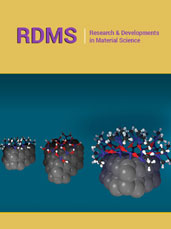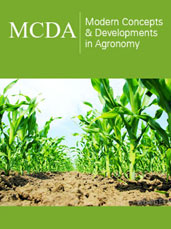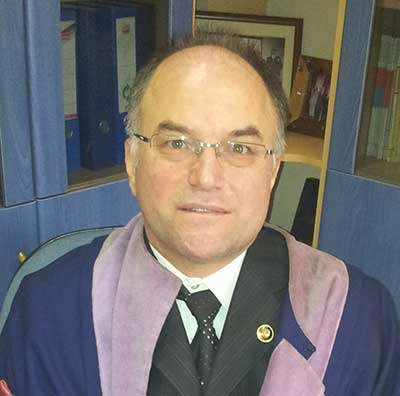- Submissions

Full Text
Open Journal of Cardiology & Heart Diseases
ACS: Its Association with Endothelial Dysfunction and Elevated Basal Sympathetic Activity
Tarun Kumar Saxena1* and Bharat Saxena2
1Department of Internal Medicine Mittal Hospital and Research Centre Pushkar Road, Ajmer & Bharat Hospital Shastri Nagar Ajmer, Rajasthan, India
2M.B.B.S. student, Institute of Medical Science & SUM Hospital, Bhubaneswar, Odisha, India
*Corresponding author: Tarun Kumar Saxena, Senior Consultant, Department of Internal Medicine Mittal Hospital and Research Centre Pushkar Road, Ajmer & Bharat Hospital Shastri Nagar Ajmer, Rajasthan, India
Submission: January 16, 2025;Published: February 03, 2025

ISSN 2578-0204Volume4 Issue4
Abstract
The exact pathophysiol[ogy of Acute Coronary Syndrome (ACS) remains elusive. Healthy endothelium provides normal flow in the coronary circulation. Endothelial dysfunction has a close association with atherosclerosis and ACS. The less commonly noticed finding is the association of high basal sympathetic discharge in ACS. The role of high basal sympathetic discharge in ACS therefore needs to be reviewed. Functions of the healthy endothelium, endothelial dysfunction, atherosclerosis risk factors, basal sympathetic discharge/Sympathetic Skin Response (SSR), and central connections are reviewed. Basal sympathetic discharge was very high in cases of ACS (spike response in SSR). Basal sympathetic discharge arises from the hypothalamus. Reduction in basal sympathetic discharge by managing lifestyle factors i.e. stress, and adequate sleep may help in the prevention of ACS.
Keywords:Acute coronary syndrome; Basal sympathetic discharge; Endothelial dysfunction
Introduction
Acute Coronary Syndrome (ACS) is marked by the rapid onset of symptoms or findings of Unstable Angina (USA), ST-Elevation Myocardial Infarction (STEMI), or Non-ST-Elevation Myocardial Infarction (Non-STEMI) in previously asymptomatic individuals, typically within 24 hours. This is due to a sudden reduction in blood flow to the heart [1]. Endothelial dysfunction plays a crucial role in the pathogenesis of ACS [2]. A healthy endothelium is vital for preventing thrombus formation due to its antithrombotic, antiplatelet, and profibrinolytic properties, while also maintaining vascular tone as required [3]. Endothelial dysfunction is characterized by the endothelium’s loss of these protective functions. Instead, it promotes a pro-thrombotic state, platelet aggregation, and the formation of atheromatous plaques, particularly in individuals with risk factors such as hypertension, diabetes, and smoking [3- 7,8].
The state of endothelium decides normal coronary flow versus endothelial dysfunction and ACS. The precise cause of endothelial dysfunction remains unclear, but several atherosclerosis risk factors [9] have been proposed in prior studies these include- elevated cholesterol levels [10-12], insulin resistance [13,14], hypertension [15], etc. The role of basal sympathetic discharge in endothelial dysfunction is least discussed in the literature therefore its role in precipitating ACS necessitates to be reviewed [8]. Basal sympathetic discharge is primarily controlled by the hypothalamus and is influenced by cortical areas such as the cingulate gyrus and neocortex [7].
Methods
Various studies have been reviewed to understand possible mechanisms of the development of ACS including properties and functions of a healthy endothelium, unhealthy endothelium (endothelial dysfunction) basal sympathetic discharge/Sympathetic Skin Response (SSR), and its central connections [1-23].
This Review is Organized into the Following Heads
Properties and functions of the endothelium
Healthy coronary endothelium: Under normal physiological conditions, the endothelium plays a critical role in preventing thrombus formation due to its antithrombotic, antiplatelet, and profibrinolytic properties, while also regulating vascular tone. The endothelium regulates vascular tone by modulating intracellular ATP (Adenosine Tri-Phosphate) production, thus ensuring the dilation of coronary vessels according to demand [8,16-18].
Endothelial dysfunction: Endothelial dysfunction is marked by increased permeability to inflammatory cells, loss of the protective barrier, leukocyte adhesion, thrombosis, and reduced vasodilation and a shift toward a pro-inflammatory and pro-thrombotic state, contributing to the development of atherosclerotic plaques. Further endothelial dysfunction results in ACS [19,20].
Clinical conditions associated with ACS
a) Unstable Angina
b) Non-ST-Elevation Myocardial Infarction (Non-STEMI)
c) ST-Elevation Myocardial Infarction (STEMI)
High basal sympathetic discharge and endothelial dysfunction (possible mechanism)
one important finding is the presence of high basal sympathetic discharge in ACS, also observed in diabetes and hypertension [6-8]. Basal sympathetic discharge refers to the flow of impulses in the sympathetic nervous system at a basal rate. The sympathetic system is continuously active secreting small amounts of epinephrine and norepinephrine at the nerve endings. This baseline discharge is necessary to maintain a normal heart rate, normal blood pressure & vital functions. Normal basal sympathetic discharge is associated with adequate ATP production at the cellular level and endothelium behaves like healthy endothelium. High basal sympathetic discharge results in an ATP mismatch (where inadequate ATP is available to meet the demand at the endothelial cellular level) and endothelium becomes unhealthy i.e. endothelial dysfunction and behaves like prothrombotic and impaired vasodilation and in severe cases results in ACS [8, 21-23].
In the absence of overt discharge, SSR (Sympathetic Skin
Response) denotes basal sympathetic discharge. Sympathetic skin
response was recorded using standard protocols with the help of
Electromyography electrodes placed on the palm and dorsum of
the hand. The cold pressor test and isometric hand grip were used
as stimulating methods. The response recorded on a computer
included latency and amplitude. Latency was calculated from
the onset of the stimulus to the beginning of the response. The
amplitude was measured from peak to peak [6].
A. Normal response- In normal basal sympathetic discharge,
there is a dome-shaped response with long latency and low
amplitude [6].
B. In hypertension and ACS high basal discharge i.e. short
latency, a high amplitude spike response is observed [6,8].
Central connections and basal sympathetic discharge
Basal sympathetic discharge arises from the hypothalamus, with possible cortical influences. The cerebral cortex has extensive connections with the hypothalamus, which receives afferents from the limbic system (cingulate gyrus), neocortex, and other regions. The hypothalamus sends efferent signals to sympathetic neurons. Thus, the cortex indirectly modulates the sympathetic nervous system [21,23]. The role of the anti-aging gene Sirtuin 1 is important to the prevention of endothelial dysfunction and ACS. Sirtuin 1 is important to the hypothalamus and brain function with relevance to basal sympathetic discharge. Sirtuin 1 activation versus Sirtuin 1 inhibition may be relevant to the reduction in basal sympathetic discharge with relevance to the prevention of ACS [24-26].
Conclusion
Basal sympathetic discharge is normal resting basal sympathetic tone necessary to maintain blood pressure and heart rate. Normal basal discharge is associated with a healthy endothelium. High basal sympathetic discharge is associated with ATP mismatch at the cellular level and leads to endothelial dysfunction and in severe cases ACS. Basal sympathetic discharge originates from the hypothalamus, with possible cortical influences. Reduction in basal sympathetic discharge by managing lifestyle factors i.e. stress, and adequate sleep may help in the prevention of ACS.
References
- https://en.wikipedia.org/wiki/Acute_coronary_syndrome
- Gutierrez E, Flammer AJ, Lerman LO, Elizaga J, Lerman A, et al. (2013) Endothelial dysfunction over the course of coronary artery disease. Eur Heart J 34(41): 3175-3181.
- Yau JW, Teoh H, Verma S (2015) Endothelial cell control of thrombosis. BMC Cardiovasc Disord 15: 130.
- Kinlay S, Ganz P (2000) Relationship between endothelial dysfunction and acute coronary syndrome: Implications for therapy. Am J Cardiol 86(8B): 10J-13J.
- Fichtlscherer S, Zeiher AM (1999) Endothelial dysfunction in patients with acute coronary syndrome. Herz 24(7): 534-543.
- Saxena T, Patidar S, Saxena M (2016) Assessment of left ventricular ejection force and sympathetic skin response in normotensive and hypertensive subjects: A double-blind observational comparative case-control study. Indian Heart J 68(5): 685-692.
- Saxena TK, Maheshwari S, Saxena M (2014) Aetiopathogenesis of type-2 diabetes mellitus: Could chronic stress play an important role? J Assoc Physicians India 62(6): 484-489.
- Saxena T, Patidar S, Verma S, Ozefa A, Saxena M (2019) Endothelial cell strengthening: Improving functions in the management of acute coronary syndrome (A double-blind randomized interventional control trial). Clinical Cardiol Cardiovascular Med 3: 17-22.
- Fruchart JC, Nierman MC, Stroes ESG, Kastelein JJP, Duriez P (2004) New risk factors for atherosclerosis and patient risk assessment. Circulation 109(23 Suppl 1): III15-19.
- Hodis HN, Mack WJ, Azen SP, Alaupovic P, Pogoda JM, et al. (1994) Triglyceride-and cholesterol-rich lipoproteins have a differential effect on mild/moderate and severe lesion progression as assessed by quantitative coronary angiography in a controlled trial of lovastatin. Circulation 90(1): 42-49.
- Morange PE, Simon C, Alessi MC, Luc G, Arveiler D, et al. (2004) Endothelial cell markers and the risk of coronary heart disease: The prospective epidemiological study of myocardial infarction (PRIME) study. Circulation 109(11): 1343-1348.
- Knopp RH (2002) Risk factors for coronary artery disease in women. Am J Cardiol 89(12A): 28E-34E.
- Meigs JB, Larson MG, Agostino RBD, Levy D, Clouse ME, et al. (2002) Coronary artery calcification in type 2 diabetes and insulin resistance: The framingham offspring study. Diabetes Care 25(8): 1313-1319.
- Muntan J, Umar H, Tandean P, Bakri S, Sanusi H, et al. (2023) The relationship between admission insulin resistance index (AIRI) and in-hospital outcome in non-diabetic acute coronary syndrome. J ASEAN Fed Endocr Soc 38(1): 7-12.
- Konstantinou K, Tsioufis C, Koumelli A, Mantzouranis M, Kasiakogias A, et al. (2019) Hypertension and patients with acute coronary syndrome: Putting blood pressure levels into perspective. J Clin Hypertens (Greenwich) 21(8):1135-1143.
- Hinsbergh VWMV (2012) Endothelium-role in the regulation of coagulation and inflammation. Semin Immunopathol 34(1): 93-106.
- Pober JS, Sessa WC (2007) Evolving functions of endothelial cells in inflammation. Nat Rev Immunol 7(10): 803-815.
- Lin Z, Kumar A, Banerjee SS, Staniszewski K, Parmar K, et al. (2005) Kruppel-like- factor 2 (KLF2) regulates endothelial thrombotic function. Circ Res 96(5): e48-e57.
- Dmitrieva NIS, Burg MB (2014) Secretion of von willebrand factor by endothelial cells links sodium to hypercoagulability and thrombosis. Proc Natl Acad Sci U S A 111(17): 6485-6490.
- Watson SP (2009) Platelet activation by extracellular matrix proteins in hemostasis and thrombosis. Curr Pharm Des 15(12): 1358-1372.
- Saxena T, Khichi G, Saxena M (2017) Cell death in stroke: Role of metabolism. Austin J Cerebrovasc Dis and stroke 4(2): 1059.
- Mario V, Arura K, Raj T (2016) The cell and its Functions. In: Hall G (Ed.), Text-book of medical physiology. (13th edn), Elsevier publishing company, Netherlands, pp. 9-16.
- Saxena T, Saxena M (2016) Possible clinical implications of high left ventricular ejection force and exaggerated sympathetic skin response in hypertensive patients. Ann Clin Exp Hypertension 4(1): 1035.
- Ian James M (2016) Anti-aging genes improve appetite regulation and reverse cell senescence and apoptosis in global populations. Advances in Aging Research 5(1): 9-26.
- Martins IJ (2018) Genomic medicine and acute cardiovascular disease progression in diabetes. Res Chron Dis 2(1): 31-33.
- Martins IJ (2017) Nutrition therapy regulates caffeine metabolism with relevance to NAFLD and induction of type 3 diabetes. J Diabetes Metab Disord 4(19): 1-9.
© 2025 Tarun Kumar Saxena. This is an open access article distributed under the terms of the Creative Commons Attribution License , which permits unrestricted use, distribution, and build upon your work non-commercially.
 a Creative Commons Attribution 4.0 International License. Based on a work at www.crimsonpublishers.com.
Best viewed in
a Creative Commons Attribution 4.0 International License. Based on a work at www.crimsonpublishers.com.
Best viewed in 







.jpg)






























 Editorial Board Registrations
Editorial Board Registrations Submit your Article
Submit your Article Refer a Friend
Refer a Friend Advertise With Us
Advertise With Us
.jpg)






.jpg)














.bmp)
.jpg)
.png)
.jpg)










.jpg)






.png)

.png)



.png)






